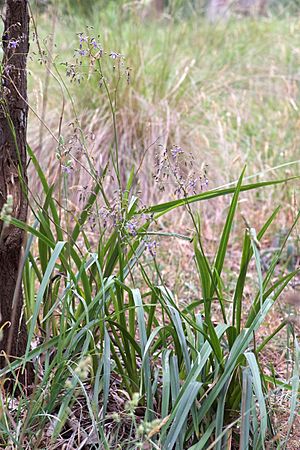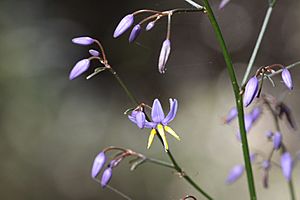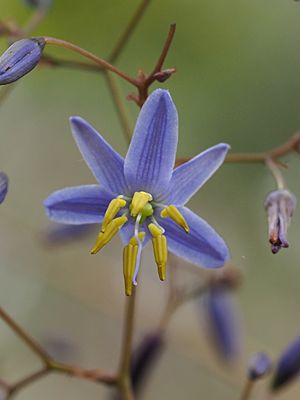Smooth flax lily facts for kids
Quick facts for kids Blueberry lily |
|
|---|---|
 |
|
| Scientific classification | |
| Genus: |
Dianella
|
| Species: |
longifolia
|


The Dianella longifolia, often called the blueberry lily, pale flax lily, smooth flax lily, or blue flax-lily, is a beautiful flowering plant. You can find it in many non-dry areas of Australia. It's a type of plant that grows in clumps. It has underground stems called rhizomes and lives for many years. This plant has leaves like grass, and its flowers can be pale blue, white, or greenish. These flowers have pale yellow parts called anthers. After flowering, it grows shiny, pale blue berries.
Contents
What Does the Blueberry Lily Look Like?
The blueberry lily is a plant that grows in clumps. It can reach about 1.5 m (4 ft 11 in) tall. Its stems are usually less than 10 cm (3.9 in) long. The leaves are folded lengthwise, just like grass blades. They are about 20–80 cm (7.9–31.5 in) long and 2–25 mm (0.079–0.984 in) wide.
Flowers and Fruit
The plant's flower stalk, called an inflorescence, is longer than its leaves. The flowers are pale blue, white, or greenish. They grow spaced out from each other. Each flower sits on a small stem called a pedicel, which is 7–16 mm (0.28–0.63 in) long. The outer flower parts, called tepals, are 6–10 mm (0.24–0.39 in) long. The inner tepals are a bit shorter, about 5.5–9 mm (0.22–0.35 in) long. Each tepal has five veins.
The stamens, which are the male parts of the flower, have yellow anthers. These anthers are where the pollen is made. The blueberry lily usually flowers in spring and summer. After the flowers, it produces small, pale blue berries. These berries are typically 3–7 mm (0.12–0.28 in) long.
How the Blueberry Lily Got Its Name
Scientists give plants two-part names. This helps everyone around the world know exactly which plant they are talking about. The Dianella longifolia was first described in 1810. This was done by a famous botanist named Robert Brown (botanist, born 1773). He wrote about it in his book, Prodromus Florae Novae Hollandiae et Insulae Van Diemen.
The second part of its scientific name, longifolia, comes from Latin. It means "long leaved." This is a good description because the plant does have long, grass-like leaves!
Different Types of Blueberry Lily
Scientists have found and named six different types, or varieties, of Dianella longifolia. These varieties are found in different parts of Australia:
- Dianella longifolia var. fragrans: This type is only found in two places near Cardwell, Queensland.
- Dianella longifolia var. grandis: This variety is common in south-eastern Australia. You can find it from near Gympie all the way to north of Adelaide.
- Dianella longifolia var. longifolia: This is the most widespread type. It grows across northern and eastern Australia, including the Kimberley region.
- Dianella longifolia var. stenophylla: This variety is found in eastern Australia. It grows from near Gladstone, Queensland to near Batemans Bay.
- Dianella longifolia var. stupata: This type mostly grows west of the Great Dividing Range in eastern Australia.
- Dianella longifolia var. surculosa: This variety is found in south-eastern Queensland and north-eastern New South Wales.
Where the Blueberry Lily Grows
The blueberry lily is a very common plant in Australia. It grows in many areas that are not too dry. You can find it in the Kimberley region, across eastern and southern Australia, and even in northern Tasmania.

